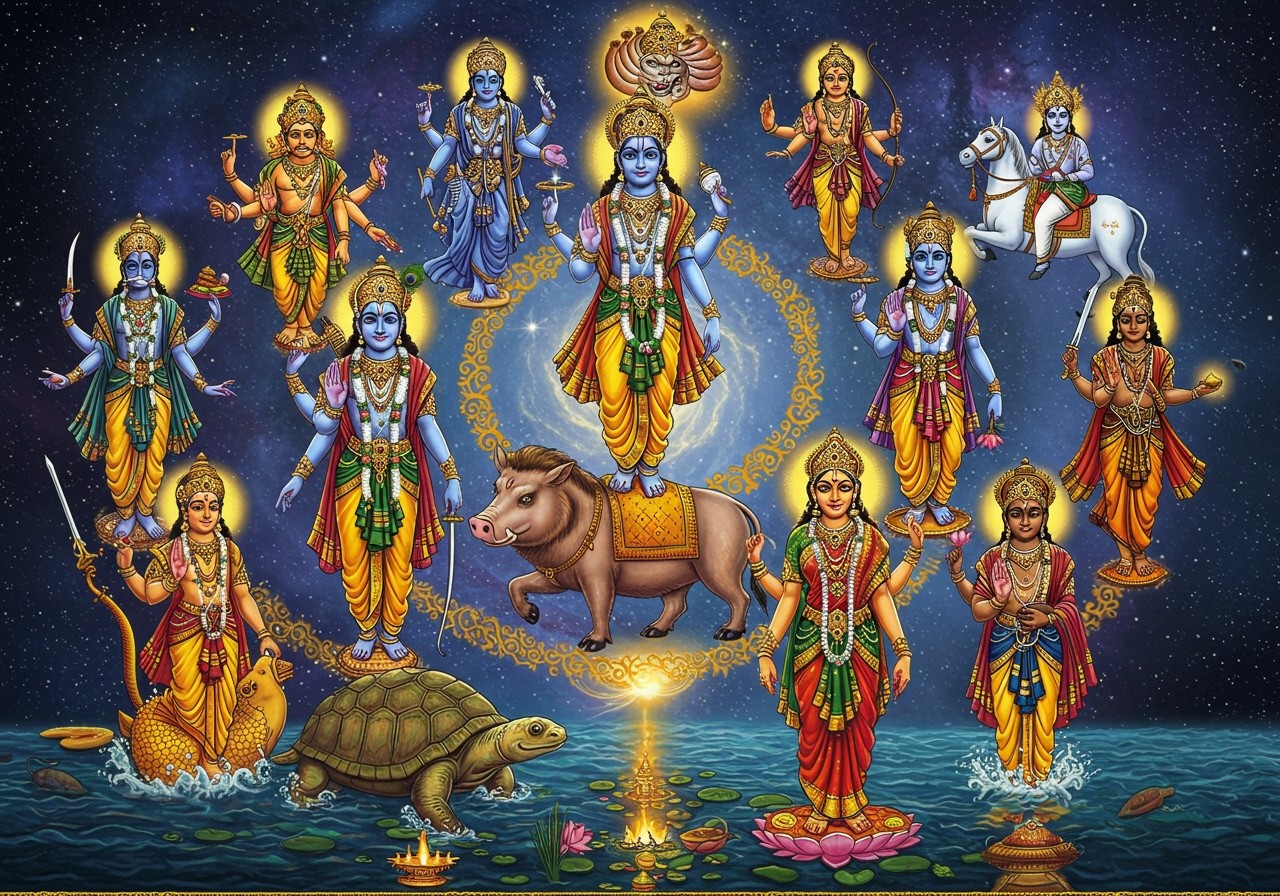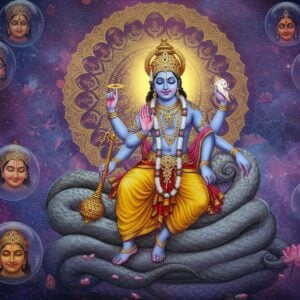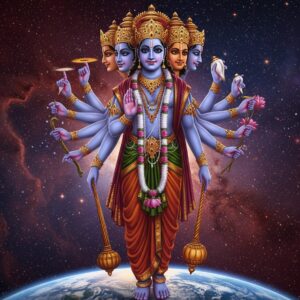
The Dashavatara stories revolve around the ten principal incarnations of Lord Vishnu, a cornerstone of Hindu mythology. These narratives are more than just myths; they impart profound life lessons and values. They hold particular significance for children as they convey traditions and morals, illustrating the distinction between right and wrong. In numerous Indian households, these tales are shared through storytelling, art, and during festivals. Let’s delve into the unique story of each avatar and its importance.
Understanding the Dashavatara
‘Dasha’ signifies ‘ten,’ and ‘avatara’ means ‘incarnation.’ In Hindu beliefs, Lord Vishnu assumes various forms to maintain balance and goodness in the world. Each avatar is associated with a distinct age or ‘yuga’ in Hindu tradition, reflecting life’s journey. The Dashavatara stories possess deep spiritual and cultural meaning, facilitating the transmission of lessons and values across generations. Here’s a glimpse at the ten avatars: Matsya, Kurma, Varaha, Narasimha, Vamana, Parashurama, Rama, Krishna, Balarama, and Kalki.
Matsya (The Fish)
In ancient times, King Manu found a small fish while performing penance. This fish, however, was no ordinary creature; it was Lord Vishnu in disguise. As Manu cared for the fish, it grew rapidly, requiring ever-larger habitats. Finally, in the ocean, the fish revealed its true form as Lord Vishnu and warned Manu of an impending great flood. Vishnu instructed Manu to construct a boat, gather animals and seeds, and weather the storm. This story teaches preparedness and faith. Children can visualize this narrative through drawings or storytelling. Explore our collection of Radha Krishna idols to bring this divine presence into your home.
Kurma (The Tortoise)
The gods and demons once sought the elixir of immortality, concealed within the Ocean of Milk. Utilizing Mount Mandara as a churning rod and a serpent as a rope, they embarked on their quest. As the mountain began to sink, Lord Vishnu transformed into Kurma, a colossal tortoise, to support the mountain on his back. This act epitomizes balance and cooperation. Through perseverance and collaboration, they achieved their objective. This story teaches children the value of teamwork. Discover our range of Laddu Gopal idols to celebrate the divine child Krishna.
Varaha (The Boar)
The demon Hiranyaksha captured the Earth and submerged it in the ocean’s depths. To retrieve it, Lord Vishnu embodied Varaha, a mighty boar. He plunged into the ocean, lifting the Earth back to safety. This avatar symbolizes protection and bravery. Children can engage with this story through art, envisioning the powerful Varaha rescuing the world. Enhance your puja rituals with our pure Arjun Chal.
Narasimha (The Lion-Man)
The fierce Narasimha avatar emerged to shield Prahlada from his tyrannical father, Hiranyakashipu. The demon king believed himself invincible due to a boon. However, Lord Vishnu, as a half-man, half-lion being, found a way to vanquish him at twilight, on the palace threshold, using his claws. This story illustrates the triumph of justice and faith over evil. Festivals commemorate this dramatic tale, captivating children’s imaginations. Find authentic puja items on poojn.in to honor Lord Narasimha.
Vamana (The Dwarf)
During King Bali’s reign over heaven and earth, Lord Vishnu appeared as Vamana, a dwarf Brahmin. Vamana requested three paces of land from Bali, but then expanded to encompass the world with his strides. Bali’s devotion prompted him to offer his head for the third step. This story emphasizes humility and wisdom. Children might enjoy enacting this story or creating artwork depicting Vamana’s transformation. Celebrate this divine incarnation with our beautiful rangoli designs.
Parashurama (The Warrior with the Axe)
Parashurama, renowned for his axe, appeared to rid the world of corrupt rulers. His story underscores duty and justice. Parashurama’s unwavering dedication to righteousness teaches responsibility. Children can explore this tale through interactive storytelling or by creating illustrations. Learn more about creating a sacred space with our guide on creating a Krishna altar.
Rama (The Prince of Ayodhya)
The epic Ramayana narrates the story of Rama, an exemplary prince who endured exile with his wife Sita and brother Lakshmana. When Ravana abducted Sita, Rama waged a great war to rescue her and reinstate dharma. This avatar is celebrated during Diwali and Dussehra. Children can learn about loyalty and perseverance through plays or drawings. Deepen your understanding of Krishna’s divine love story with our blog post on Krishna and Radha.
Krishna (The Divine Statesman)
Krishna’s life is replete with adventures and wisdom. As a child, he vanquished malevolent forces; as an adult, he guided the Pandavas in the Mahabharata war. His teachings in the Bhagavad Gita impart timeless wisdom. Janmashtami celebrates Krishna’s birth with joy and devotion. Kids can connect with Krishna’s story through dance or music. Explore the symbolism of Krishna’s flute on our blog.
Balarama (The Ploughman)
Balarama, Krishna’s elder brother, is known for his strength and his weapon, the plough. He represents courage and protection. Celebrate Janmashtami with our collection of Laddu Gopal idols.
Kalki (The Future Incarnation)
Kalki, the avatar yet to arrive, is prophesied to appear at the close of Kali Yuga to restore righteousness. This avatar embodies hope and renewal. Children can explore imaginative storytelling or create drawings envisioning Kalki’s advent. Immerse yourself in the devotional music of Krishna bhajans.
These Dashavatara stories offer profound life lessons, providing children with insights into values and traditions while engaging their creativity and curiosity. Find everything you need for your spiritual journey on poojn.in.


